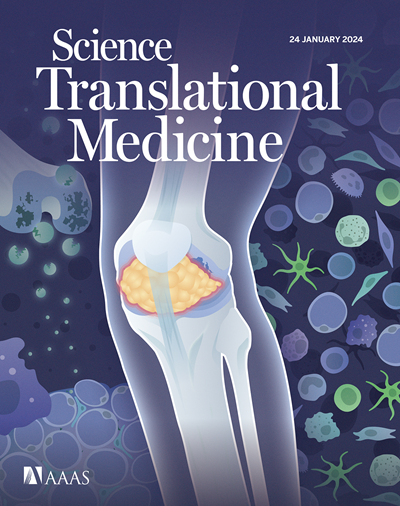CD23+IgG1+ memory B cells are poised to switch to pathogenic IgE production in food allergy
IF 15.8
1区 医学
Q1 CELL BIOLOGY
引用次数: 0
Abstract
Food allergy is caused by allergen-specific immunoglobulin E (IgE) antibodies, but little is known about the B cell memory of persistent IgE responses. Here, we describe, in human pediatric peanut allergy, a population of CD23+IgG1+ memory B cells arising in type 2 immune responses that contain high-affinity peanut-specific clones and generate IgE-producing cells upon activation. The frequency of CD23+IgG1+ memory B cells correlated with circulating concentrations of IgE in children with peanut allergy. A corresponding population of “type 2–marked” IgG1+ memory B cells was identified in single-cell RNA sequencing experiments. These cells differentially expressed interleukin-4 (IL-4)– and IL-13–regulated genes, such as FCER2/CD23+, IL4R, and germline IGHE, and carried highly mutated B cell receptors (BCRs). In children with high concentrations of serum peanut-specific IgE, high-affinity B cells that bind the main peanut allergen Ara h 2 mapped to the population of “type 2–marked” IgG1+ memory B cells and included clones with convergent BCRs across different individuals. Our findings indicate that CD23+IgG1+ memory B cells transcribing germline IGHE are a unique memory population containing precursors of high-affinity pathogenic IgE-producing cells that are likely to be involved in the long-term persistence of peanut allergy.
CD23+IgG1+ 记忆 B 细胞准备好在食物过敏症中转为产生致病性 IgE。
食物过敏是由过敏原特异性免疫球蛋白 E (IgE) 抗体引起的,但人们对持续性 IgE 反应的 B 细胞记忆却知之甚少。在这里,我们描述了在人类小儿花生过敏症中,2 型免疫反应中产生的 CD23+IgG1+ 记忆 B 细胞群,它们含有高亲和力的花生特异性克隆,并在激活后产生产生 IgE 的细胞。CD23+IgG1+ 记忆 B 细胞的频率与花生过敏患儿的 IgE 循环浓度相关。在单细胞 RNA 测序实验中发现了相应的 "2 型标记 "IgG1+ 记忆 B 细胞群。这些细胞不同程度地表达白细胞介素-4(IL-4)和IL-13调控基因,如FCER2/CD23+、IL4R和种系IGHE,并携带高度突变的B细胞受体(BCR)。在血清花生特异性 IgE 浓度较高的儿童中,能与主要花生过敏原 Ara h 2 结合的高亲和性 B 细胞映射到 "2 型标记 "IgG1+ 记忆 B 细胞群中,并包括不同个体中具有趋同 BCR 的克隆。我们的研究结果表明,转录种系 IGHE 的 CD23+IgG1+ 记忆 B 细胞是一个独特的记忆群体,其中含有高亲和力致病性 IgE 生成细胞的前体,这些细胞很可能参与了花生过敏的长期持续性。
本文章由计算机程序翻译,如有差异,请以英文原文为准。
求助全文
约1分钟内获得全文
求助全文
来源期刊

Science Translational Medicine
CELL BIOLOGY-MEDICINE, RESEARCH & EXPERIMENTAL
CiteScore
26.70
自引率
1.20%
发文量
309
审稿时长
1.7 months
期刊介绍:
Science Translational Medicine is an online journal that focuses on publishing research at the intersection of science, engineering, and medicine. The goal of the journal is to promote human health by providing a platform for researchers from various disciplines to communicate their latest advancements in biomedical, translational, and clinical research.
The journal aims to address the slow translation of scientific knowledge into effective treatments and health measures. It publishes articles that fill the knowledge gaps between preclinical research and medical applications, with a focus on accelerating the translation of knowledge into new ways of preventing, diagnosing, and treating human diseases.
The scope of Science Translational Medicine includes various areas such as cardiovascular disease, immunology/vaccines, metabolism/diabetes/obesity, neuroscience/neurology/psychiatry, cancer, infectious diseases, policy, behavior, bioengineering, chemical genomics/drug discovery, imaging, applied physical sciences, medical nanotechnology, drug delivery, biomarkers, gene therapy/regenerative medicine, toxicology and pharmacokinetics, data mining, cell culture, animal and human studies, medical informatics, and other interdisciplinary approaches to medicine.
The target audience of the journal includes researchers and management in academia, government, and the biotechnology and pharmaceutical industries. It is also relevant to physician scientists, regulators, policy makers, investors, business developers, and funding agencies.
 求助内容:
求助内容: 应助结果提醒方式:
应助结果提醒方式:


